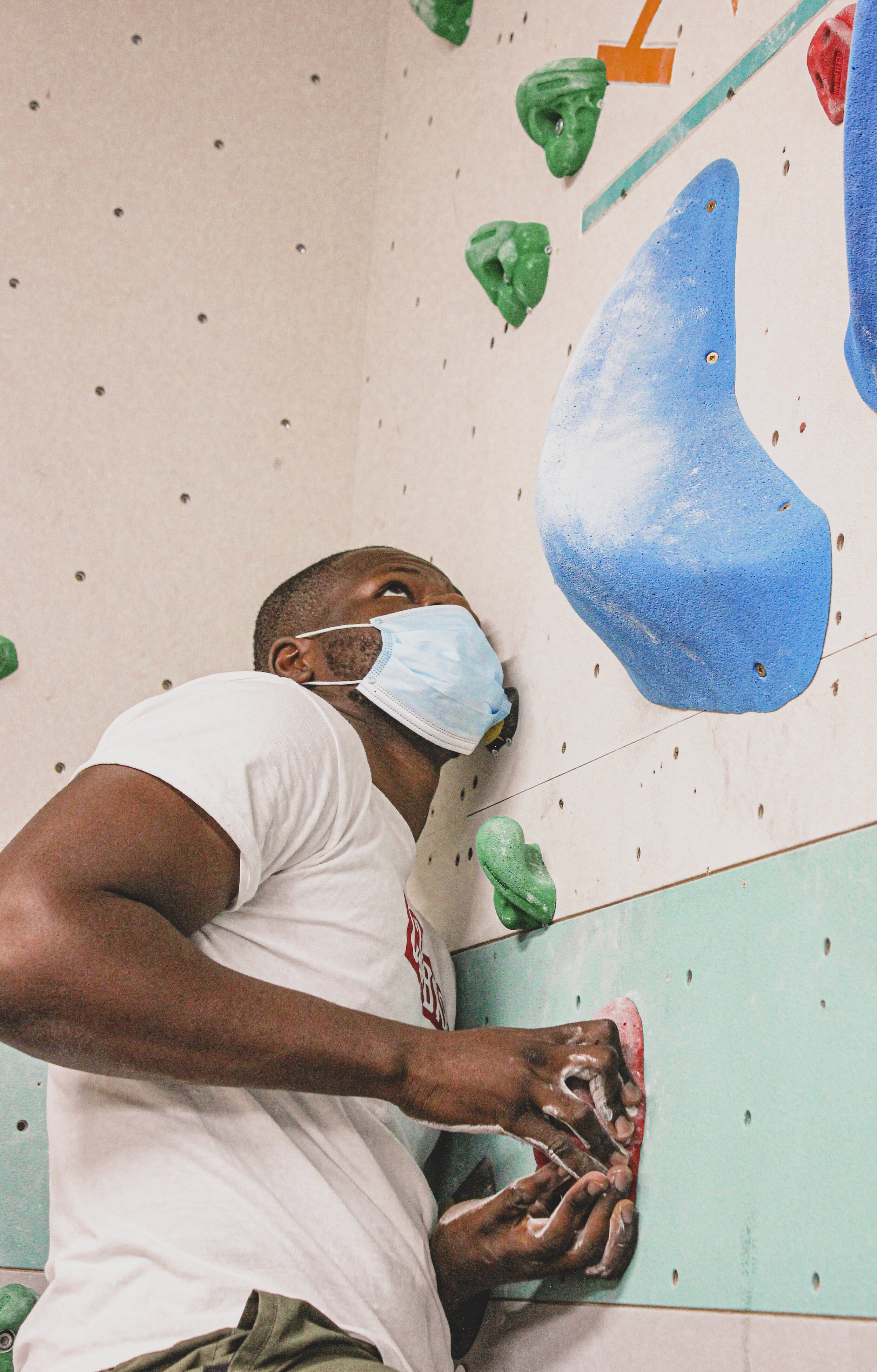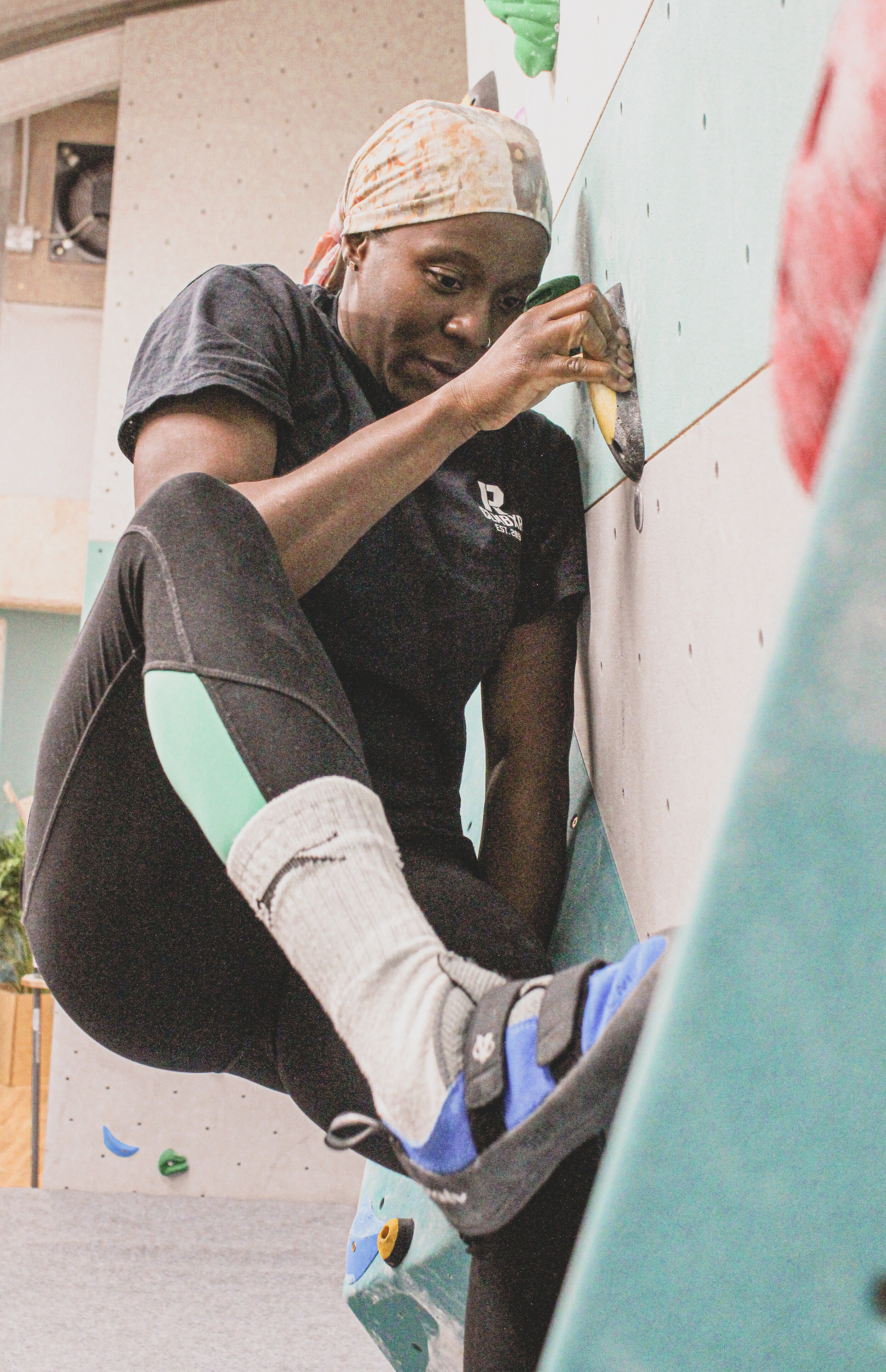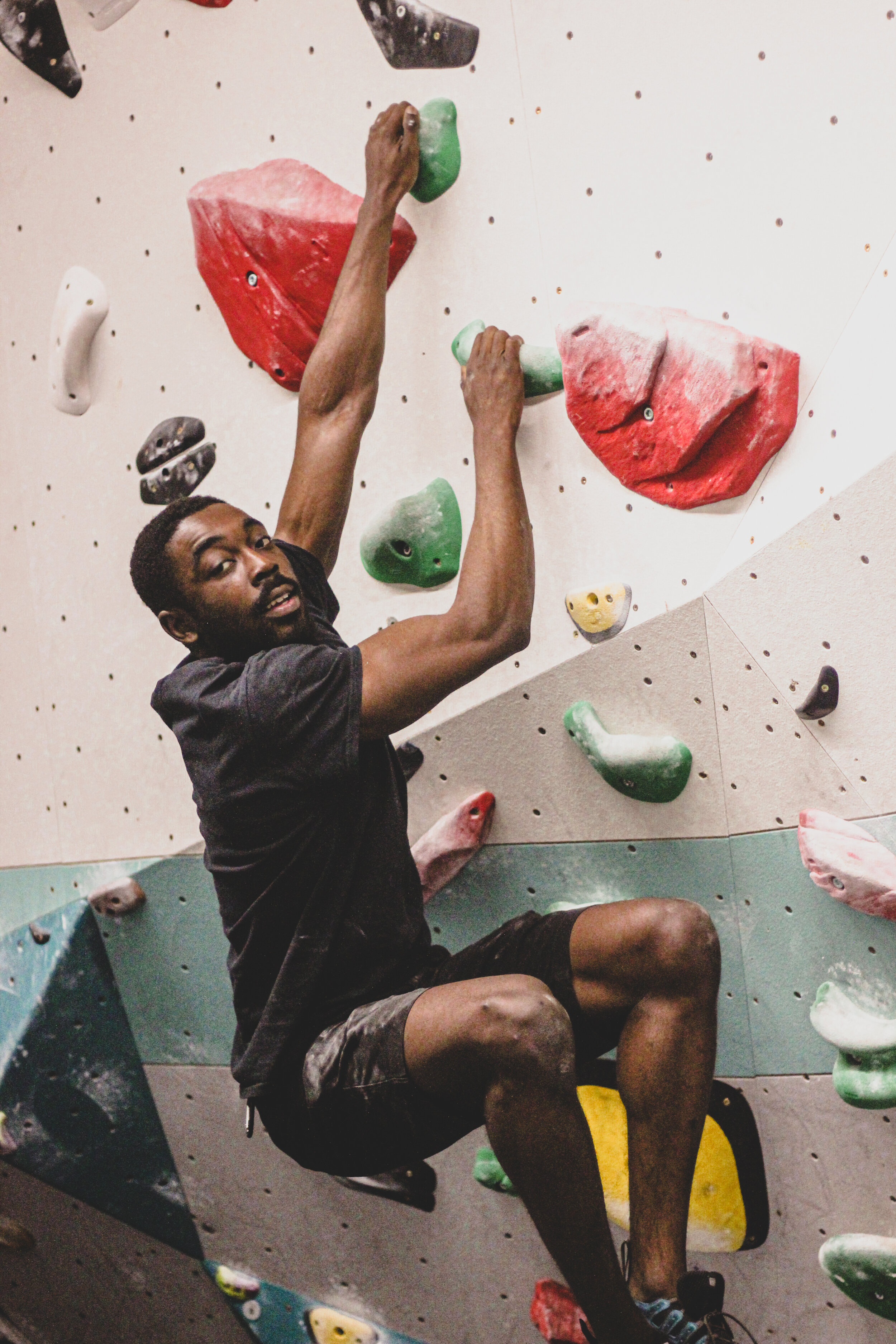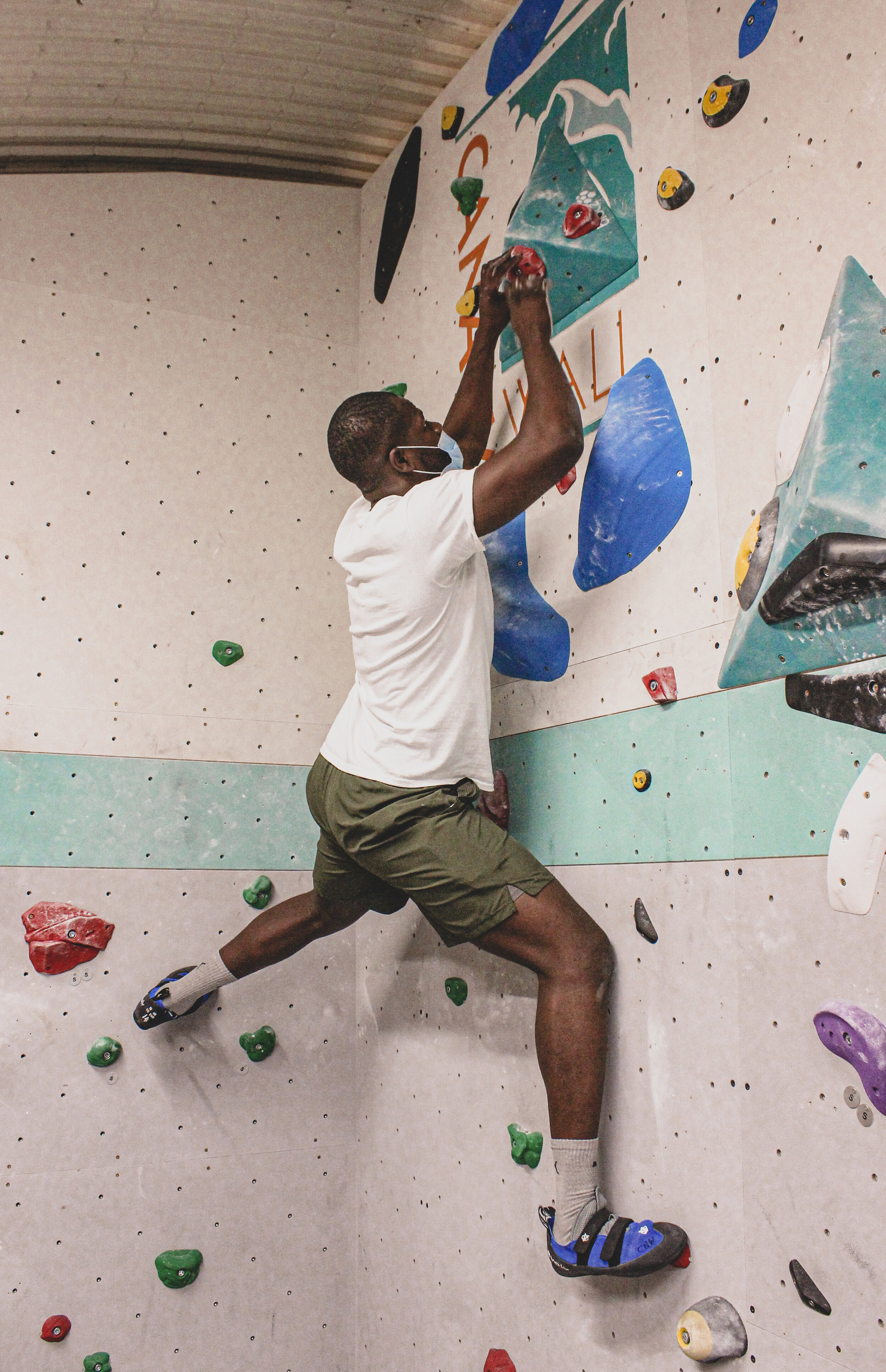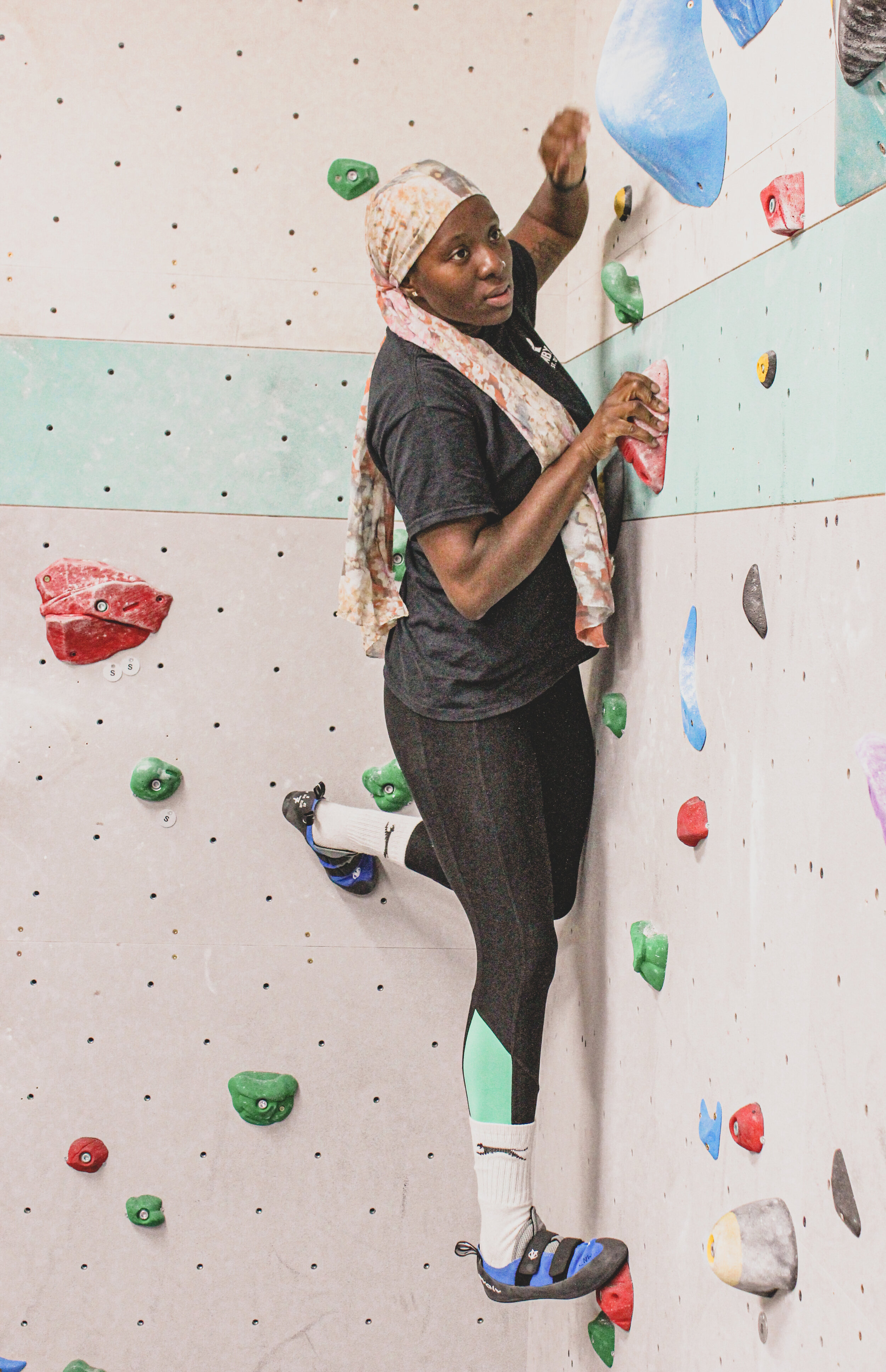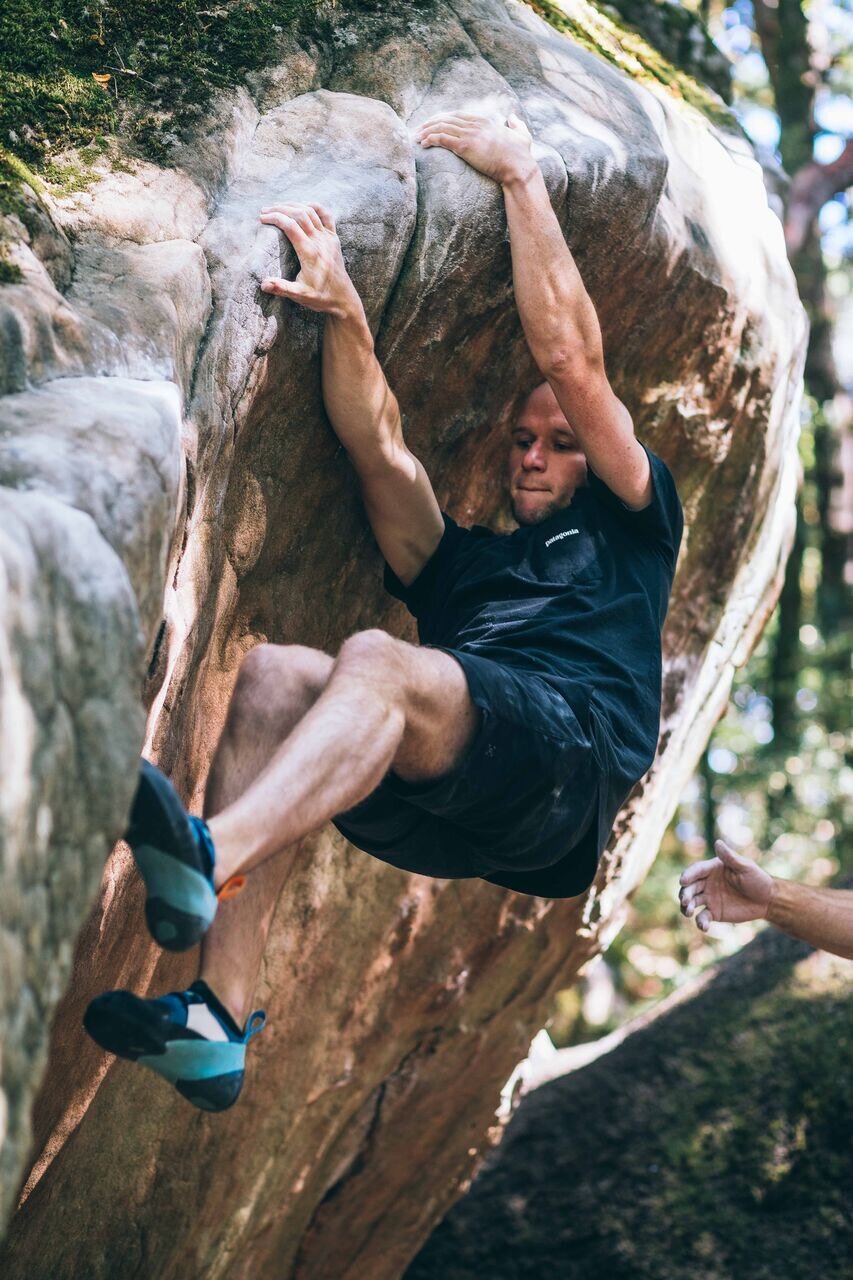PREMIER CREW
CLMBXR | ROTIMI ODUKOYA
IN CONVERSATION WITH LIAM LONSDALE
PHOTOS BY CHRIS MITCHELL / LAKELAND CLIMBING CENTRES
London, England, 2020. Modern-day Crew Culture is making an appearance within the climbing community. At the heart of the movement is a collective called CLMBXR. I sat down with founder Rotimi Odukoya to find out what the story is.
LL: Rotimi, thanks so much for chatting with me. Let’s get straight into it. How is CLMBXR coping with the ‘Rona? I’ve been wondering how it’s possible to keep a crew going …
ROTIMI: Pleasure to be here. Yeah, it’s not easy, but we’ve been making it work. London right now is in Tier 2 of the British severity levels, which means people from different households aren’t supposed to meet, but businesses like gyms and bars are open. Basically I send all of the CLMBXR crew to one gym and we ‘distance’ ourselves there. We are all meeting up, masked up.
LL: I’m glad to hear you’re still making it work. Let’s talk about the origin story and go back to where it all began. How did CLMBXR start? Why did you start it? What does it look like now?
A small collective of CLMBXR members, Rotimi is centre © CLMBXR COLLECTION
ROTIMI: Let me give you the origin of the origin story. I was transitioning careers in March of 2019, to keep fit I was attending a bootcamp. Every Monday of the bootcamp we would go climbing as part of the workout and after about 6 weeks, one of my friends who was training with me asked me to just go climbing, on our own time. I have been into gym work and calisthenics for a long time, and so climbing felt good and fun. We ended up going to Mile End Climbing Wall, one of the original walls in the UK. I loved it immediately. It felt like the perfect blend of a physical and mental challenge, and I knew I wanted to go back. Then I shared some of my climbing on my social media and a friend reached out and was like “hey, where is that?”. When I told him it was Mile End he was blown away. We spent time in Mile End regularly because it’s where we go to church, literally ten minutes walk from the wall. And he was like, “how come we’ve never seen this before?” Climbing felt like this kind of hidden world, like, if you know, you know.
That friend asked to join me on my next session. Another friend asked the same thing. I decided to start a WhatsApp group to keep everyone in the loop, and we started climbing together every Saturday.
After a few weeks, I decided it would be fun to set up an Instagram page to document our climbing. I filmed some short clips. More people saw what we were doing and asked to be involved and it just grew organically from there. Honestly, it wasn't even close to being a formulated plan.
Recently we created an official membership scheme to keep track of everything, and to support the organisation of the crew. We currently have 44 paying members. Signing up gives members access to our group chat, and the ability to use our climbing wall discounts with partner centres.
Rotimi Odukoya © CLMBXR COLLECTION
LL: One of our core beliefs at KAYA is that climbing is a diverse sport, and should be represented as such. There are so many different races and ethnicities within our deeply passionate community. One of our biggest problems is that historically the climbing media seemed to tell that story poorly, if at all. We want to tell the stories of people in our community, properly. I’ve never heard anybody describe themselves as a ‘Black climber’, or a ‘white climber’ , we always say “I’m a climber”. That’s our identity and that’s what unites us. And it’s time we started to tell that story.
Recently I saw a video clip of Molly Thompson-Smith in an interview, I’ve known Molly since she was a little kid competing in the youth scene. In the clip she talked about her experience of climbing with CLMBXR. About how she arrived at the climbing gym and in her words, “had to pick her jaw up off the floor” when she actually saw five other Black climbers in the gym. She described having a weight lifted off her shoulders … and how she had never even realised how much being ‘the only Black climber’ had affected her. Now that CLMBXR is an established crew, is increasing representation and creating a safe space for Black and brown climbers part of your ethos?
Rotimi: You know, because this was such an organic thing, I never thought “oh, we need to fill a quota”, or “I should start a representation group”. I didn’t start CLMBXR because I thought ”climbing needs more black people”. I am Black, the majority of my friends are Black, so we are just all Black. We have this innate chemistry and culture between ourselves that’s infectious and promotes the growth of the group, it's difficult to put words to to be honest. Anyway, when we are together, climbing, we are super supportive of each other, you can't help but notice who we are. We are caring for each other, we are supporting each other, we are vocal, and passionate, and cheering each other on. Being visible, being a community, that opened other Black people in our extended network to thinking “oh hey, this is fun, this is cool I can try that too”. I think the majority of Black Londoners have never even heard of climbing, I certainly didn’t know it existed. Sharing it with more and more people is pretty special. In all honesty I prefer not to call us a “Black community or crew”, I prefer just to say we are a community.
“I sometimes wish we could just be a normal group of friends, having fun. Like, why do we need to have a mission statement?”
LL: It’s really interesting to hear about the community forming that way around, rather than it being set up as an affinity group from the outset.
Rotimi: It is interesting actually, because we have been kind of pigeon holed into being ‘Black climbers’ in a sense. I think that’s because there is a lack of representation in the space, and so we end up looking like an anomaly. I mean, we are an anomaly in a sense. That’s why I would rather just call CLMBXR a community rather than a BAME* group. In one sense, I am very happy that we can be the face of representing the BAME community in climbing. I fully understand the importance of representation, and I know that what we are doing has an impact. In another sense I sometimes wish we could just be a normal group of friends, having fun. Like, why do we need to have a mission statement?
LL: Do you feel a responsibility now, even though you didn’t seek it?
Rotimi: For sure. We have eyeballs on us. We have attention. The Media is watching. The climbing industry is watching. The sports industry is watching. We recently got contacted by adidas and did a big campaign with them. That was serious. To have huge brands looking at us and wanting to push us out there, wanting to show what we are doing by using us in a campaign, that’s kind of mad. It certainly made me think. I definitely do feel the pressure of that.
LL: How do you deal with that pressure?
Rotimi: I don’t know?! Keep climbing? Honestly the only thing I want is for my crew to enjoy themselves. The last thing I want is for CLMBXR members to feel like they are being watched and can’t do what they want. I don't want us to lose that innocence. I don't want it to get rigid. I love how we organically came together to start, and I love that it still feels natural even now. Like, if we bring someone new, everyone in the community brings warmth to them, they make that person feel welcome, part of this one big family. It would break my heart to lose that because I felt pressured into growing our membership artificially, or partnering with a brand that took control of what we do. I want us to be free, and to have autonomy in our own direction.
LL: I know you’ve spoken with the godfather of the running crew movement Charlie Dark on this … right?
Rotimi: Yeah man, Charlie knows his stuff. Run Dem Crew had a big big sponsor back in the day and I know it raised dilemmas and questions. Charlie knows what it is to have that pressure. He gave me some great advice around brand partnerships for a crew like ours, which was alongs the lines of “Never be beholden to one brand. Don’t let one brand own the crew.” That’s been really useful to keep in the back of my mind when talking to companies as we continue on this journey.
LL: Great advice. He absolutely knows his stuff. OK, slight change of direction. Who makes your youtube videos?
Rotimi: I do. All of it. All the filming, all the editing.
LL: Amazing. I love them. I mean, I’ve been consuming climbing content for as long as I’ve been climbing … which pretty much predates youtube. I’ve been creating content myself for over a decade. In climbing we often focus on the hardest, or the scariest, or the biggest.Your videos have such an incredible energy … they’re watchable, very fun, very real. The vibe is really difficult to describe. But I love watching the CLMBXR community figure it all out … it's like being with you for a session … it gets me fired up to go climbing. It's infectious. It encapsulated one of the things that hooked me about climbing in the first place. I think you hit the jackpot with your videos in replicating something that is very difficult to replicate! Talk to me about CLMBXR and YouTube.
Rotimi: I had been on YouTube before actually. When I was 17 I dropped out of college and I was filming my life as a college dropout. Speaking to artists and celebs around London … and then I stopped. I lost confidence in the importance of my story. When CLMBXR started to gain some momentum I recognised that what we are doing right now in this space makes us really unique. I felt like it was important to document that. It felt like an easy, and pertinent way to do that was to capture our sessions and put them out for people to see, and YouTube seemed like the right place for that. I felt like it gave us room to grow. I mean, I think Instagram is great for photos and short clips here and there, but I felt like video was the best way to share our story in a more long form way. And you're right, we are truly figuring it out. I have only been climbing for a year. Most of the people in CLMBXR have been climbing for the same amount of time or less. There are a few members who have been climbing longer, but on average we are mostly newcomers. We are enjoying ourselves and teaching one another. YouTube feels like a good medium to record and showcase that learning.
LL: What does the future of CLMBXR look like?
Rotimi: I really don't know mate. Ha. I work full time … climbing is still a hobby. Unless I get a partnership with a major organisation, or some sort of extended funding it’ll stay as it is, organic growth and a core community. One idea I have is to take CLMBXR around the country, touring different cities and gyms. Another idea is to open a climbing space of our own. Those things require a lot of cash and time. So honestly, I don't know. I have no concrete plan, I am purely going with the flow.
LL: How do you find the time to do all this?
Rotimi: Good question. I don’t even know to be honest. I love it so I make it work. The last video we put out I was editing for hours and hours, I went through about 70 different clips to select the right stuff for our video. It’s a lot. I need to figure out a way to be more disciplined so that it doesn't take days and days to edit a video. Maybe I’ll just stick to one battery per session.
LL: What does CLMBXR need and why do you need it?
Rotimi: Well, brand partnerships enable our growth, especially partnerships with bigger brands and a long term view. Climbing is still a peripheral sport right now, we believe that it could be bigger, should be bigger. Climbing makes you feel good. It’s unique in that way. We want more people to experience that feeling. Once somebody gets the opportunity to climb a couple of times, they get bitten by ‘the bug’ that everyone talks about, it's hard to explain to people that haven't been bitten . We have an opportunity to really make climbing grow further, and for people to feel the benefits. The sport is on the come up. Pre Covid I was plotting to do some sort of festival, an event uniting Black British music … and climbing. There is this great opportunity to diversify climbing. Maybe 2021 we can get that going.
I think it's a great sport to mix with other athletes. Like, climbing can benefit from bringing athletes from other sports into the community to broaden the reach. Imagine someone like Anthony Joshua, or Stormzy climbing? The technical barrier to entry is reasonably low, like, it's not like tennis, where hitting the sweet spot is actually quite difficult, and relies on a lot of different techniques and skills … pretty much anyone can get on a climbing wall and do something, and keep climbing, and find the love for that movement. I think that’s a great opportunity to bring popularity and attention.
LL: That is truly one of my favourite things about climbing. That you, who has been climbing for a year, me who has been climbing for +15 years, and someone like Alex Megos who is one of the best climbers in the world … could all be climbing together, on the same panels, in the same gym. I don’t know of any other sports like that, where we can all be trying our absolute hardest, in the same space at the same time.
Like, you can’t rock up to a tennis court and knock a ball around w Roger Federer, or turn up to a basketball court and play a game of pick up with Lebron James. But you absolutely could be enjoying a session with Kai Lightner, at any gym.
How do people sign up for CLMBXR?
Rotimi: If any climbers are London based that want to join us, just get in touch. WE want to see you at CLMBXR. All abilities are welcome. Folks can sign up online on our website to join our Telegram group. They pay the fee and then get integrated. That's where our members arrange to meet throughout the week too. I guarantee two days per week that I will be there to climb. Usually they are Monday and Saturday. I like to be there, as the leader, on those two days because that way if someone is coming for the first time I can meet them and be there to show them what CLMBXR is all about. The membership also gives the climbers access to discounts that I mentioned earlier at the LCC gyms (VauxWall East/West, HarroWall, RavensWall, CroyWall, Canary Wall) and also Yonder.
LL: Do you have a criteria to join?
Rotimi: Our partnerships with LCC and Yonder are based on suppporting the creation of comfortable spaces for BAME people to climb, so we are focussed on offering the membership to underrepresented groups within climbing. That said we have do have one white member who has been with us since very early on, and she is a huge supporter of the organisation.
LL: Aside from the community itself, what keeps you going with CLMBXR?
Rotimi: I have a friend, Temi. He has a podcast called the 90’s Baby Show. I am constantly impressed by how far he has progressed. I am continually inspired by how consistent he is. Every single Monday for the past four years he hasn’t missed a podcast, that consistency has really benefited him and it’s paid off and I really respect that. He takes what he does so seriously, and i want to apply that same work ethic to my CLMBXR. That inspiration keeps me going, knowing that if I keep pushing, we will really get somewhere.
LL: Do you have any mantras or mottos that you live by?
Rotimi: You know, Nike says “JUST DO IT”, I say, “JUST TRY”. We never know what is around the corner. If we just try, we might surprise ourselves. Try, try, try.
*BAME, meaning Black Asian Minority Ethnic is the British acronym for the demographic referred to as BIPOC in the USA.
FIND CLMBXR on KAYA
CLMBXR is a climbing community based in london, englanD
TO FIND OUT MORE ABOUT CLMBXR CLICK HERE | CLMBXR YOUTUBE
About the Author:
The Author at Castle Rock, CA | 2019 © Alton Richardson




